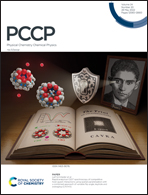Adsorption properties of pyramidal superatomic molecules based on the structural framework of the Au20 cluster†
Abstract
The pyramidal Au20 cluster is a highly inert and stable superatomic molecule, but it is not suitable as a potential catalyst for covalent bond activations, e.g., CO oxidation reaction. Herein, the adsorption and electronic properties of CO molecules on various pyramidal clusters based on the structural framework of Au20 are investigated using density functional theory. According to the SVB model, we constructed isoelectronic superatomic molecules with different pyramid configurations by replacing the vertex atoms of the Au20 using metal M atoms (M = Li, Be, Ni, Cu, and Zn group atoms). After the CO molecules are adsorbed on the vertex atoms of these metal clusters, we analyzed the CO adsorption energies, C–O bond stretching frequencies, and electronic properties of the adsorption structures. It was found that the adsorption of CO molecules results in minimal changes in the parent geometries of the pyramidal clusters, and most adsorption structures are consistent with the geometry of CO adsorption at the vertex site of the Au20 cluster. There are significant red shifts when CO molecules are adsorbed on the Ni/Pd/Pt atoms of the clusters, and their CO adsorption energies were also greater. The molecular orbitals and density of states reveal that there are overlaps between the frontier orbitals of the clusters and CO, and the electronic structure of NiAu19− is not sensitive to CO. The ETS-NOCV analysis shows that the increase in the density of the bonding area caused by the orbital interactions between the fragments is higher than the decrease in the density of the bonding area caused by Pauli repulsion, presenting that the direction of charge flow in the deformation density is from CO → clusters. From energy decomposition analysis (EDA) and NPA charge, we find a predominant covalent nature of the contributions in CO⋯M interactions (σ-donation). Our study indicates that the SVB model provides a new direction to expand the superatomic catalysts from the superatom clusters, which also provides inference for the extension of the single atom catalysis.



 Please wait while we load your content...
Please wait while we load your content...